Information Systems & IT Solution
VerifiedAdded on 2023/06/18
|11
|3456
|146
AI Summary
This report discusses information systems and IT solutions, including theories, methods, and techniques related to design and development for McAfee and MS Office software. It also covers DSS, ESS, TPS, MIS, and KMS information systems, the concept of globalization, and the effects of IT on globalization. Additionally, it explores the risks associated with information systems outsourcing, the importance of IT infrastructure in digital transformation, and provides examples of digital infrastructure.
Contribute Materials
Your contribution can guide someone’s learning journey. Share your
documents today.
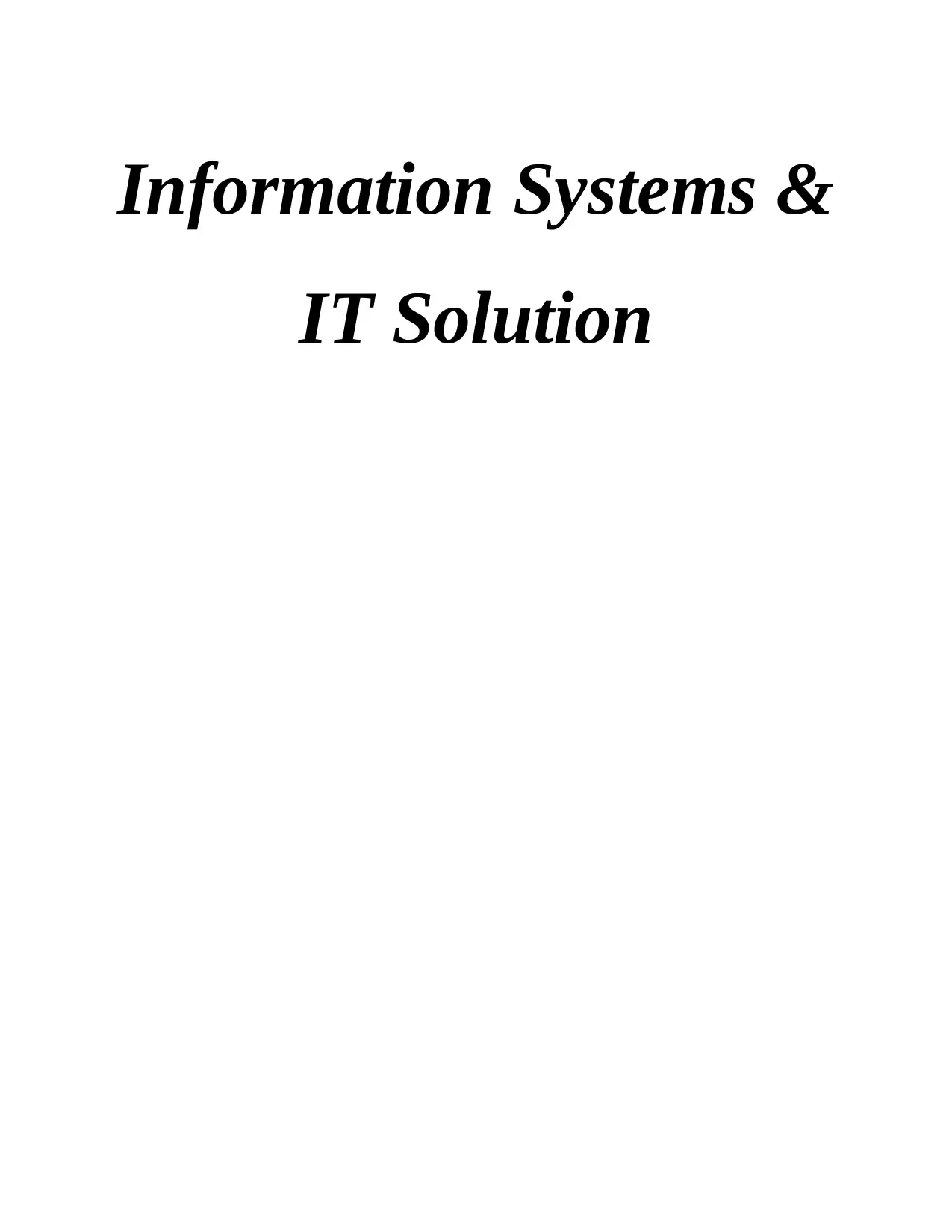
Information Systems &
IT Solution
IT Solution
Secure Best Marks with AI Grader
Need help grading? Try our AI Grader for instant feedback on your assignments.
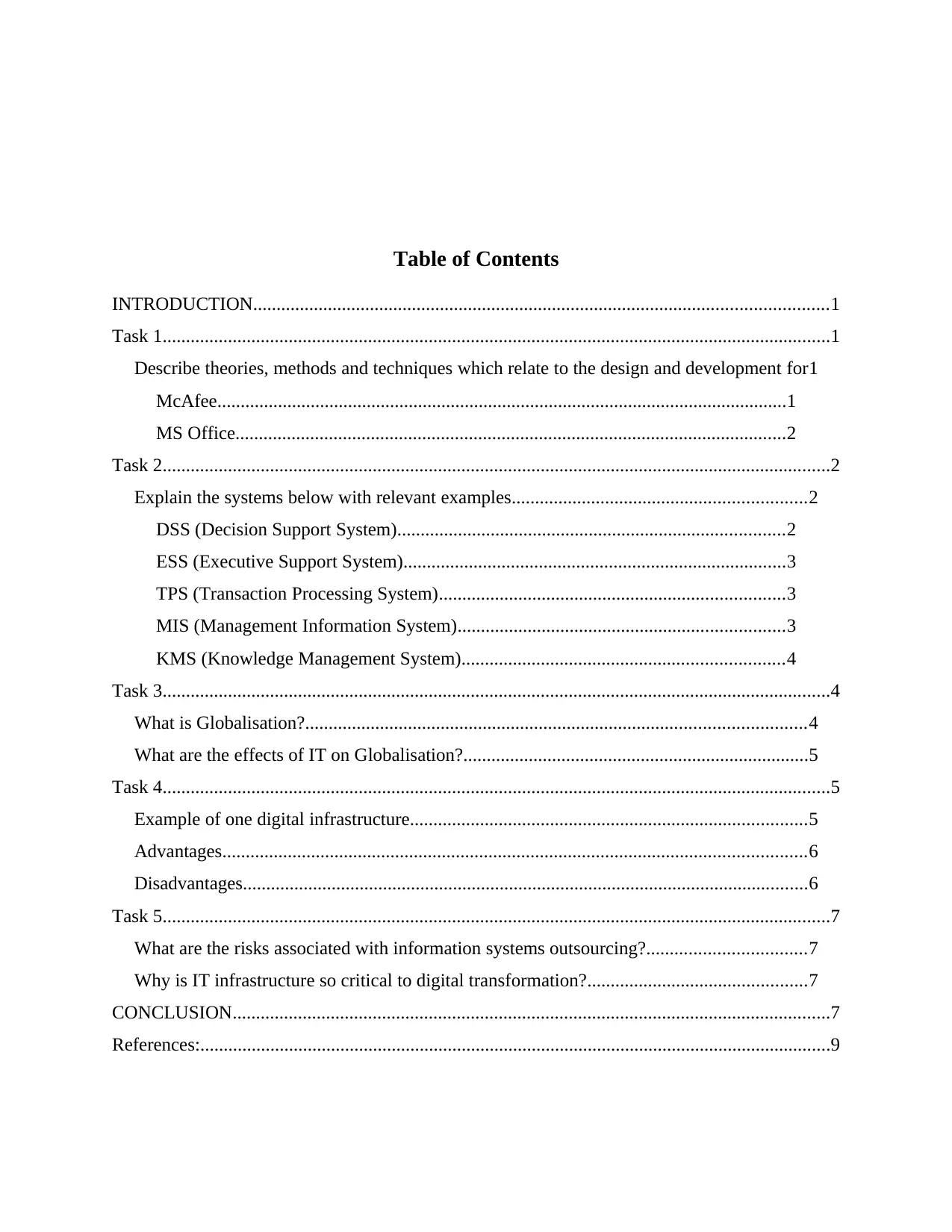
Table of Contents
INTRODUCTION...........................................................................................................................1
Task 1...............................................................................................................................................1
Describe theories, methods and techniques which relate to the design and development for1
McAfee..........................................................................................................................1
MS Office......................................................................................................................2
Task 2...............................................................................................................................................2
Explain the systems below with relevant examples...............................................................2
DSS (Decision Support System)...................................................................................2
ESS (Executive Support System)..................................................................................3
TPS (Transaction Processing System)..........................................................................3
MIS (Management Information System)......................................................................3
KMS (Knowledge Management System).....................................................................4
Task 3...............................................................................................................................................4
What is Globalisation?...........................................................................................................4
What are the effects of IT on Globalisation?..........................................................................5
Task 4...............................................................................................................................................5
Example of one digital infrastructure.....................................................................................5
Advantages.............................................................................................................................6
Disadvantages.........................................................................................................................6
Task 5...............................................................................................................................................7
What are the risks associated with information systems outsourcing?..................................7
Why is IT infrastructure so critical to digital transformation?...............................................7
CONCLUSION................................................................................................................................7
References:.......................................................................................................................................9
INTRODUCTION...........................................................................................................................1
Task 1...............................................................................................................................................1
Describe theories, methods and techniques which relate to the design and development for1
McAfee..........................................................................................................................1
MS Office......................................................................................................................2
Task 2...............................................................................................................................................2
Explain the systems below with relevant examples...............................................................2
DSS (Decision Support System)...................................................................................2
ESS (Executive Support System)..................................................................................3
TPS (Transaction Processing System)..........................................................................3
MIS (Management Information System)......................................................................3
KMS (Knowledge Management System).....................................................................4
Task 3...............................................................................................................................................4
What is Globalisation?...........................................................................................................4
What are the effects of IT on Globalisation?..........................................................................5
Task 4...............................................................................................................................................5
Example of one digital infrastructure.....................................................................................5
Advantages.............................................................................................................................6
Disadvantages.........................................................................................................................6
Task 5...............................................................................................................................................7
What are the risks associated with information systems outsourcing?..................................7
Why is IT infrastructure so critical to digital transformation?...............................................7
CONCLUSION................................................................................................................................7
References:.......................................................................................................................................9
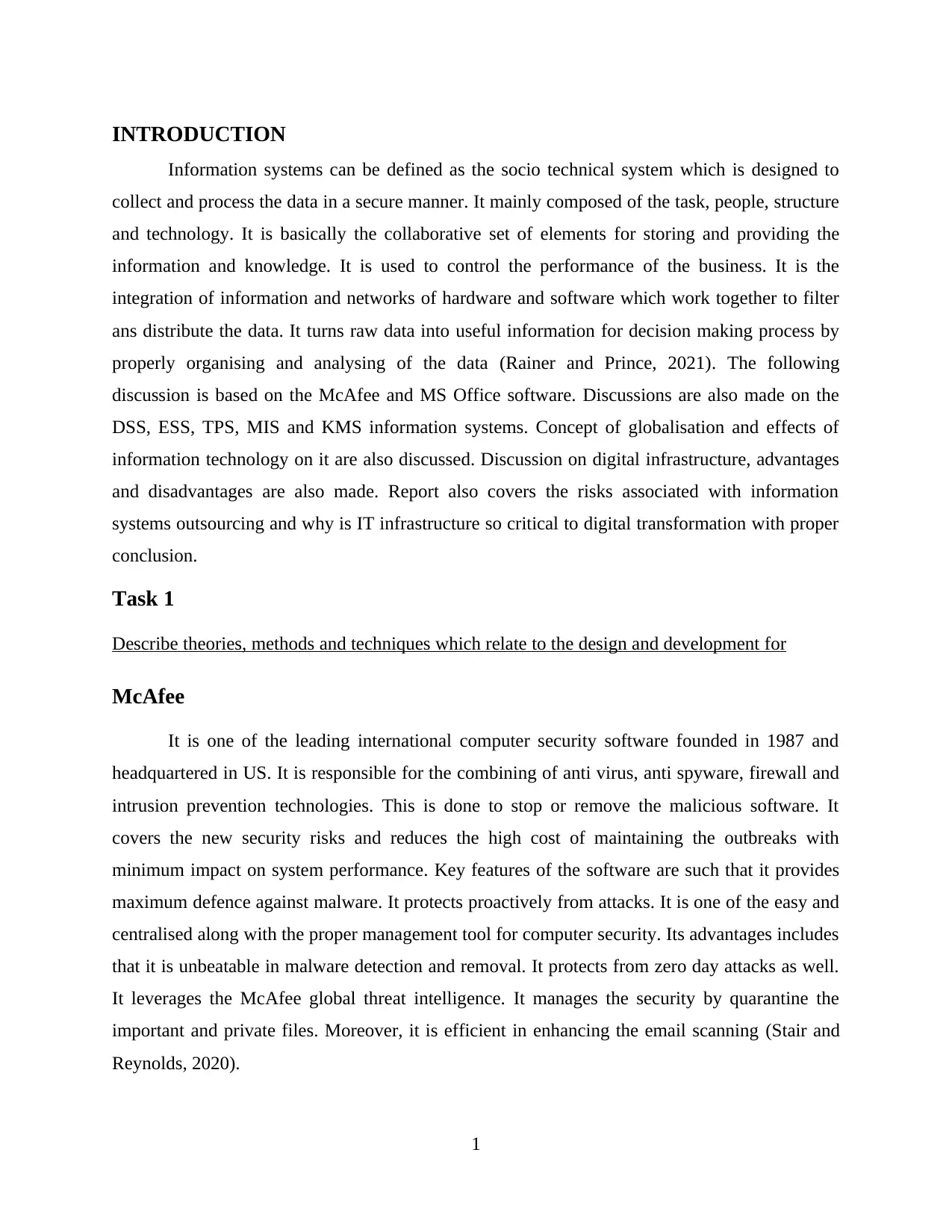
INTRODUCTION
Information systems can be defined as the socio technical system which is designed to
collect and process the data in a secure manner. It mainly composed of the task, people, structure
and technology. It is basically the collaborative set of elements for storing and providing the
information and knowledge. It is used to control the performance of the business. It is the
integration of information and networks of hardware and software which work together to filter
ans distribute the data. It turns raw data into useful information for decision making process by
properly organising and analysing of the data (Rainer and Prince, 2021). The following
discussion is based on the McAfee and MS Office software. Discussions are also made on the
DSS, ESS, TPS, MIS and KMS information systems. Concept of globalisation and effects of
information technology on it are also discussed. Discussion on digital infrastructure, advantages
and disadvantages are also made. Report also covers the risks associated with information
systems outsourcing and why is IT infrastructure so critical to digital transformation with proper
conclusion.
Task 1
Describe theories, methods and techniques which relate to the design and development for
McAfee
It is one of the leading international computer security software founded in 1987 and
headquartered in US. It is responsible for the combining of anti virus, anti spyware, firewall and
intrusion prevention technologies. This is done to stop or remove the malicious software. It
covers the new security risks and reduces the high cost of maintaining the outbreaks with
minimum impact on system performance. Key features of the software are such that it provides
maximum defence against malware. It protects proactively from attacks. It is one of the easy and
centralised along with the proper management tool for computer security. Its advantages includes
that it is unbeatable in malware detection and removal. It protects from zero day attacks as well.
It leverages the McAfee global threat intelligence. It manages the security by quarantine the
important and private files. Moreover, it is efficient in enhancing the email scanning (Stair and
Reynolds, 2020).
1
Information systems can be defined as the socio technical system which is designed to
collect and process the data in a secure manner. It mainly composed of the task, people, structure
and technology. It is basically the collaborative set of elements for storing and providing the
information and knowledge. It is used to control the performance of the business. It is the
integration of information and networks of hardware and software which work together to filter
ans distribute the data. It turns raw data into useful information for decision making process by
properly organising and analysing of the data (Rainer and Prince, 2021). The following
discussion is based on the McAfee and MS Office software. Discussions are also made on the
DSS, ESS, TPS, MIS and KMS information systems. Concept of globalisation and effects of
information technology on it are also discussed. Discussion on digital infrastructure, advantages
and disadvantages are also made. Report also covers the risks associated with information
systems outsourcing and why is IT infrastructure so critical to digital transformation with proper
conclusion.
Task 1
Describe theories, methods and techniques which relate to the design and development for
McAfee
It is one of the leading international computer security software founded in 1987 and
headquartered in US. It is responsible for the combining of anti virus, anti spyware, firewall and
intrusion prevention technologies. This is done to stop or remove the malicious software. It
covers the new security risks and reduces the high cost of maintaining the outbreaks with
minimum impact on system performance. Key features of the software are such that it provides
maximum defence against malware. It protects proactively from attacks. It is one of the easy and
centralised along with the proper management tool for computer security. Its advantages includes
that it is unbeatable in malware detection and removal. It protects from zero day attacks as well.
It leverages the McAfee global threat intelligence. It manages the security by quarantine the
important and private files. Moreover, it is efficient in enhancing the email scanning (Stair and
Reynolds, 2020).
1
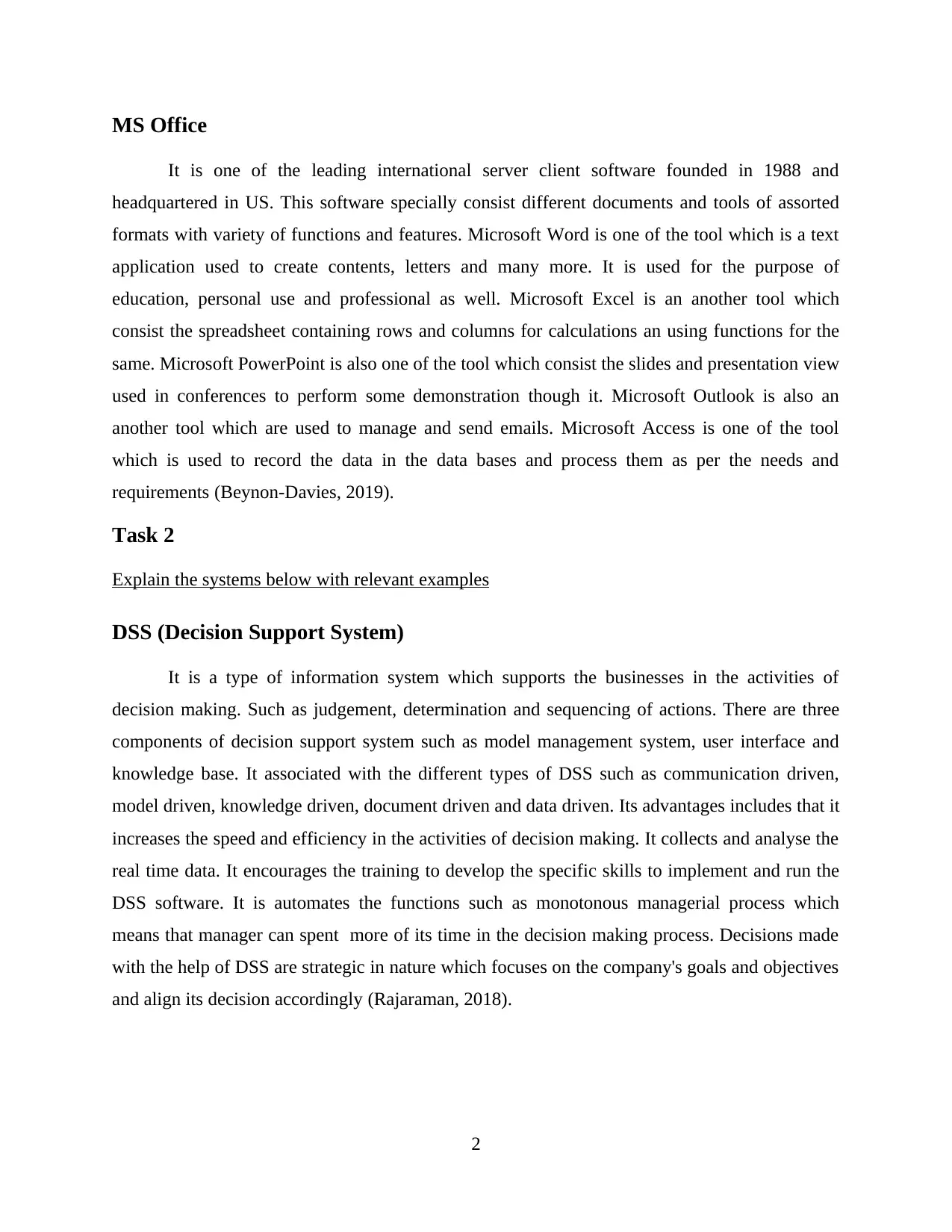
MS Office
It is one of the leading international server client software founded in 1988 and
headquartered in US. This software specially consist different documents and tools of assorted
formats with variety of functions and features. Microsoft Word is one of the tool which is a text
application used to create contents, letters and many more. It is used for the purpose of
education, personal use and professional as well. Microsoft Excel is an another tool which
consist the spreadsheet containing rows and columns for calculations an using functions for the
same. Microsoft PowerPoint is also one of the tool which consist the slides and presentation view
used in conferences to perform some demonstration though it. Microsoft Outlook is also an
another tool which are used to manage and send emails. Microsoft Access is one of the tool
which is used to record the data in the data bases and process them as per the needs and
requirements (Beynon-Davies, 2019).
Task 2
Explain the systems below with relevant examples
DSS (Decision Support System)
It is a type of information system which supports the businesses in the activities of
decision making. Such as judgement, determination and sequencing of actions. There are three
components of decision support system such as model management system, user interface and
knowledge base. It associated with the different types of DSS such as communication driven,
model driven, knowledge driven, document driven and data driven. Its advantages includes that it
increases the speed and efficiency in the activities of decision making. It collects and analyse the
real time data. It encourages the training to develop the specific skills to implement and run the
DSS software. It is automates the functions such as monotonous managerial process which
means that manager can spent more of its time in the decision making process. Decisions made
with the help of DSS are strategic in nature which focuses on the company's goals and objectives
and align its decision accordingly (Rajaraman, 2018).
2
It is one of the leading international server client software founded in 1988 and
headquartered in US. This software specially consist different documents and tools of assorted
formats with variety of functions and features. Microsoft Word is one of the tool which is a text
application used to create contents, letters and many more. It is used for the purpose of
education, personal use and professional as well. Microsoft Excel is an another tool which
consist the spreadsheet containing rows and columns for calculations an using functions for the
same. Microsoft PowerPoint is also one of the tool which consist the slides and presentation view
used in conferences to perform some demonstration though it. Microsoft Outlook is also an
another tool which are used to manage and send emails. Microsoft Access is one of the tool
which is used to record the data in the data bases and process them as per the needs and
requirements (Beynon-Davies, 2019).
Task 2
Explain the systems below with relevant examples
DSS (Decision Support System)
It is a type of information system which supports the businesses in the activities of
decision making. Such as judgement, determination and sequencing of actions. There are three
components of decision support system such as model management system, user interface and
knowledge base. It associated with the different types of DSS such as communication driven,
model driven, knowledge driven, document driven and data driven. Its advantages includes that it
increases the speed and efficiency in the activities of decision making. It collects and analyse the
real time data. It encourages the training to develop the specific skills to implement and run the
DSS software. It is automates the functions such as monotonous managerial process which
means that manager can spent more of its time in the decision making process. Decisions made
with the help of DSS are strategic in nature which focuses on the company's goals and objectives
and align its decision accordingly (Rajaraman, 2018).
2
Secure Best Marks with AI Grader
Need help grading? Try our AI Grader for instant feedback on your assignments.
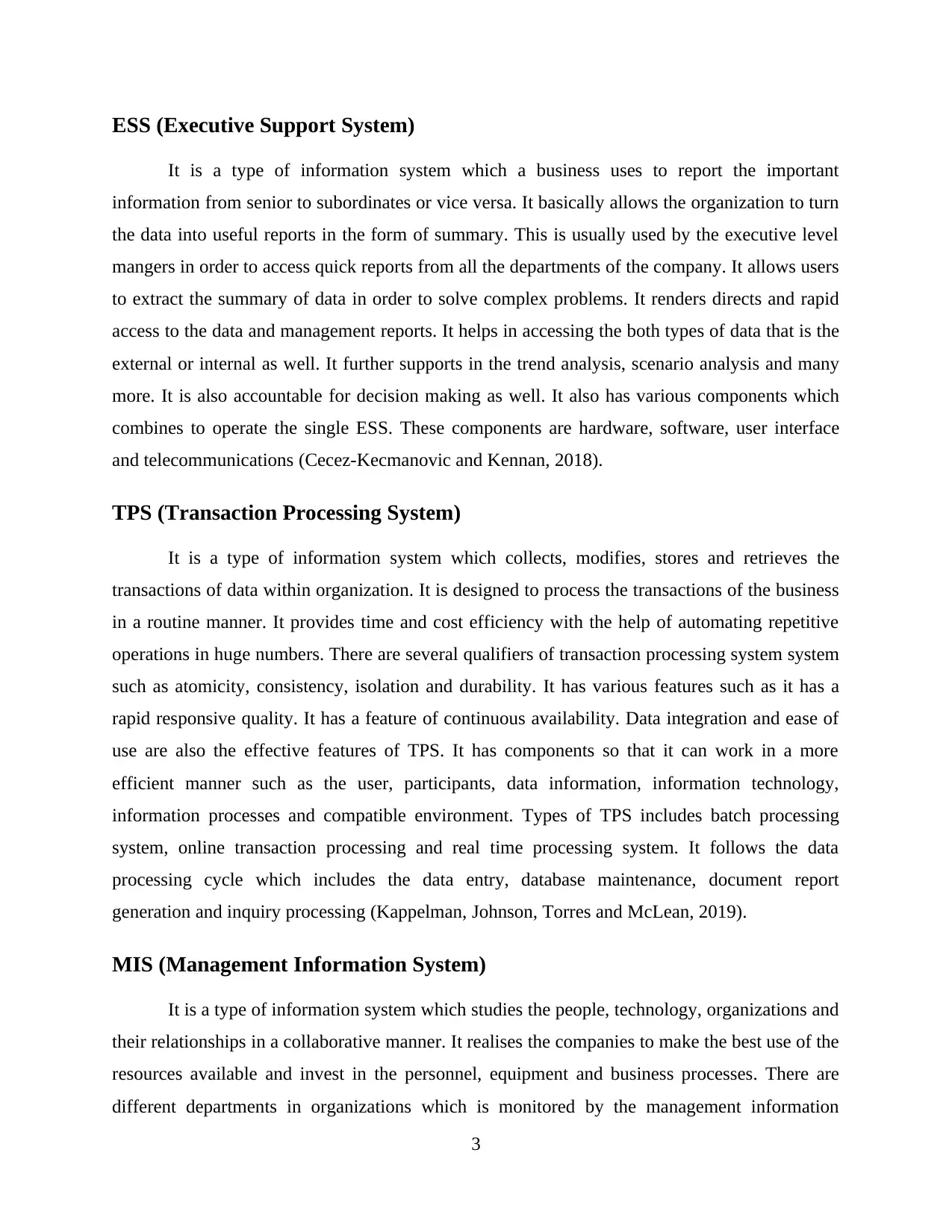
ESS (Executive Support System)
It is a type of information system which a business uses to report the important
information from senior to subordinates or vice versa. It basically allows the organization to turn
the data into useful reports in the form of summary. This is usually used by the executive level
mangers in order to access quick reports from all the departments of the company. It allows users
to extract the summary of data in order to solve complex problems. It renders directs and rapid
access to the data and management reports. It helps in accessing the both types of data that is the
external or internal as well. It further supports in the trend analysis, scenario analysis and many
more. It is also accountable for decision making as well. It also has various components which
combines to operate the single ESS. These components are hardware, software, user interface
and telecommunications (Cecez-Kecmanovic and Kennan, 2018).
TPS (Transaction Processing System)
It is a type of information system which collects, modifies, stores and retrieves the
transactions of data within organization. It is designed to process the transactions of the business
in a routine manner. It provides time and cost efficiency with the help of automating repetitive
operations in huge numbers. There are several qualifiers of transaction processing system system
such as atomicity, consistency, isolation and durability. It has various features such as it has a
rapid responsive quality. It has a feature of continuous availability. Data integration and ease of
use are also the effective features of TPS. It has components so that it can work in a more
efficient manner such as the user, participants, data information, information technology,
information processes and compatible environment. Types of TPS includes batch processing
system, online transaction processing and real time processing system. It follows the data
processing cycle which includes the data entry, database maintenance, document report
generation and inquiry processing (Kappelman, Johnson, Torres and McLean, 2019).
MIS (Management Information System)
It is a type of information system which studies the people, technology, organizations and
their relationships in a collaborative manner. It realises the companies to make the best use of the
resources available and invest in the personnel, equipment and business processes. There are
different departments in organizations which is monitored by the management information
3
It is a type of information system which a business uses to report the important
information from senior to subordinates or vice versa. It basically allows the organization to turn
the data into useful reports in the form of summary. This is usually used by the executive level
mangers in order to access quick reports from all the departments of the company. It allows users
to extract the summary of data in order to solve complex problems. It renders directs and rapid
access to the data and management reports. It helps in accessing the both types of data that is the
external or internal as well. It further supports in the trend analysis, scenario analysis and many
more. It is also accountable for decision making as well. It also has various components which
combines to operate the single ESS. These components are hardware, software, user interface
and telecommunications (Cecez-Kecmanovic and Kennan, 2018).
TPS (Transaction Processing System)
It is a type of information system which collects, modifies, stores and retrieves the
transactions of data within organization. It is designed to process the transactions of the business
in a routine manner. It provides time and cost efficiency with the help of automating repetitive
operations in huge numbers. There are several qualifiers of transaction processing system system
such as atomicity, consistency, isolation and durability. It has various features such as it has a
rapid responsive quality. It has a feature of continuous availability. Data integration and ease of
use are also the effective features of TPS. It has components so that it can work in a more
efficient manner such as the user, participants, data information, information technology,
information processes and compatible environment. Types of TPS includes batch processing
system, online transaction processing and real time processing system. It follows the data
processing cycle which includes the data entry, database maintenance, document report
generation and inquiry processing (Kappelman, Johnson, Torres and McLean, 2019).
MIS (Management Information System)
It is a type of information system which studies the people, technology, organizations and
their relationships in a collaborative manner. It realises the companies to make the best use of the
resources available and invest in the personnel, equipment and business processes. There are
different departments in organizations which is monitored by the management information
3
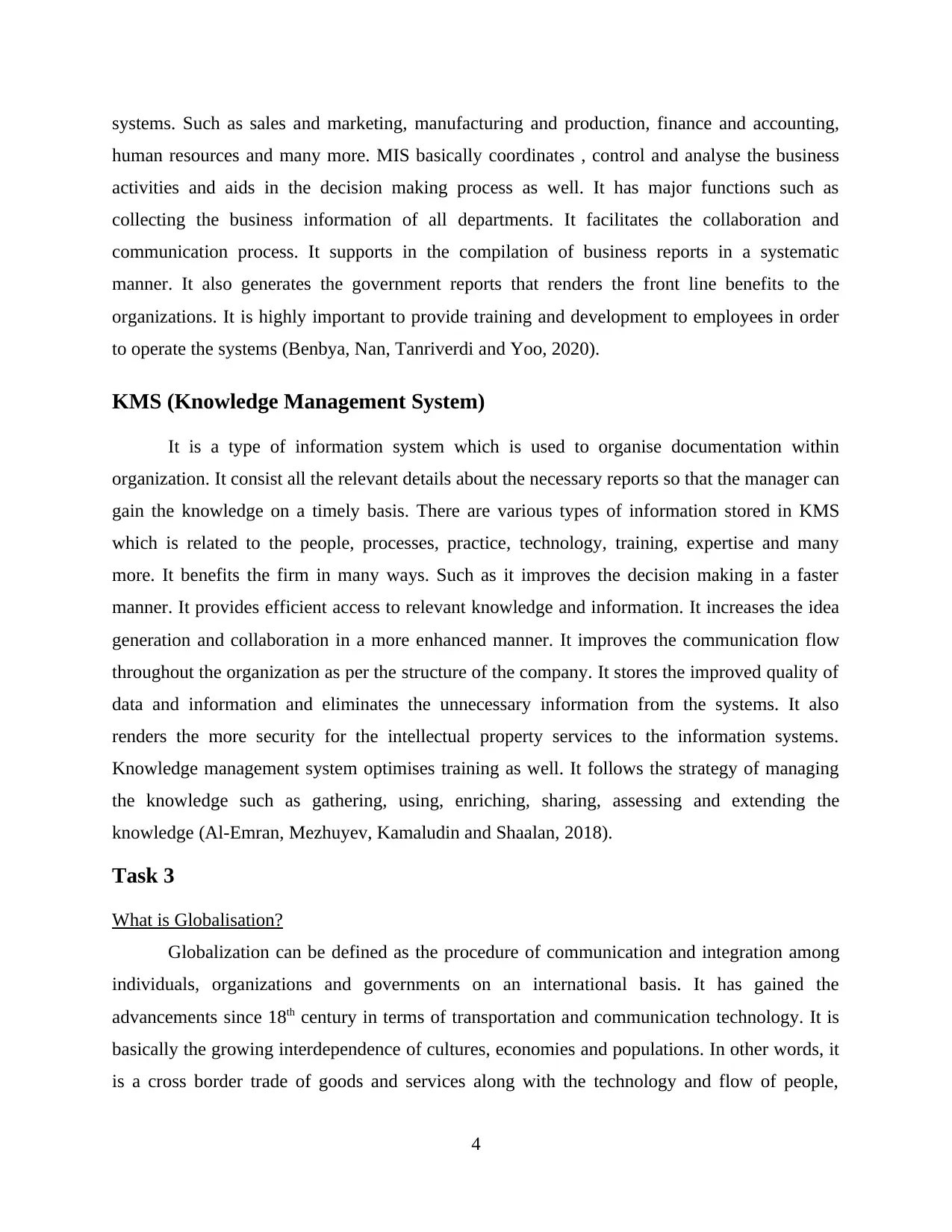
systems. Such as sales and marketing, manufacturing and production, finance and accounting,
human resources and many more. MIS basically coordinates , control and analyse the business
activities and aids in the decision making process as well. It has major functions such as
collecting the business information of all departments. It facilitates the collaboration and
communication process. It supports in the compilation of business reports in a systematic
manner. It also generates the government reports that renders the front line benefits to the
organizations. It is highly important to provide training and development to employees in order
to operate the systems (Benbya, Nan, Tanriverdi and Yoo, 2020).
KMS (Knowledge Management System)
It is a type of information system which is used to organise documentation within
organization. It consist all the relevant details about the necessary reports so that the manager can
gain the knowledge on a timely basis. There are various types of information stored in KMS
which is related to the people, processes, practice, technology, training, expertise and many
more. It benefits the firm in many ways. Such as it improves the decision making in a faster
manner. It provides efficient access to relevant knowledge and information. It increases the idea
generation and collaboration in a more enhanced manner. It improves the communication flow
throughout the organization as per the structure of the company. It stores the improved quality of
data and information and eliminates the unnecessary information from the systems. It also
renders the more security for the intellectual property services to the information systems.
Knowledge management system optimises training as well. It follows the strategy of managing
the knowledge such as gathering, using, enriching, sharing, assessing and extending the
knowledge (Al-Emran, Mezhuyev, Kamaludin and Shaalan, 2018).
Task 3
What is Globalisation?
Globalization can be defined as the procedure of communication and integration among
individuals, organizations and governments on an international basis. It has gained the
advancements since 18th century in terms of transportation and communication technology. It is
basically the growing interdependence of cultures, economies and populations. In other words, it
is a cross border trade of goods and services along with the technology and flow of people,
4
human resources and many more. MIS basically coordinates , control and analyse the business
activities and aids in the decision making process as well. It has major functions such as
collecting the business information of all departments. It facilitates the collaboration and
communication process. It supports in the compilation of business reports in a systematic
manner. It also generates the government reports that renders the front line benefits to the
organizations. It is highly important to provide training and development to employees in order
to operate the systems (Benbya, Nan, Tanriverdi and Yoo, 2020).
KMS (Knowledge Management System)
It is a type of information system which is used to organise documentation within
organization. It consist all the relevant details about the necessary reports so that the manager can
gain the knowledge on a timely basis. There are various types of information stored in KMS
which is related to the people, processes, practice, technology, training, expertise and many
more. It benefits the firm in many ways. Such as it improves the decision making in a faster
manner. It provides efficient access to relevant knowledge and information. It increases the idea
generation and collaboration in a more enhanced manner. It improves the communication flow
throughout the organization as per the structure of the company. It stores the improved quality of
data and information and eliminates the unnecessary information from the systems. It also
renders the more security for the intellectual property services to the information systems.
Knowledge management system optimises training as well. It follows the strategy of managing
the knowledge such as gathering, using, enriching, sharing, assessing and extending the
knowledge (Al-Emran, Mezhuyev, Kamaludin and Shaalan, 2018).
Task 3
What is Globalisation?
Globalization can be defined as the procedure of communication and integration among
individuals, organizations and governments on an international basis. It has gained the
advancements since 18th century in terms of transportation and communication technology. It is
basically the growing interdependence of cultures, economies and populations. In other words, it
is a cross border trade of goods and services along with the technology and flow of people,
4
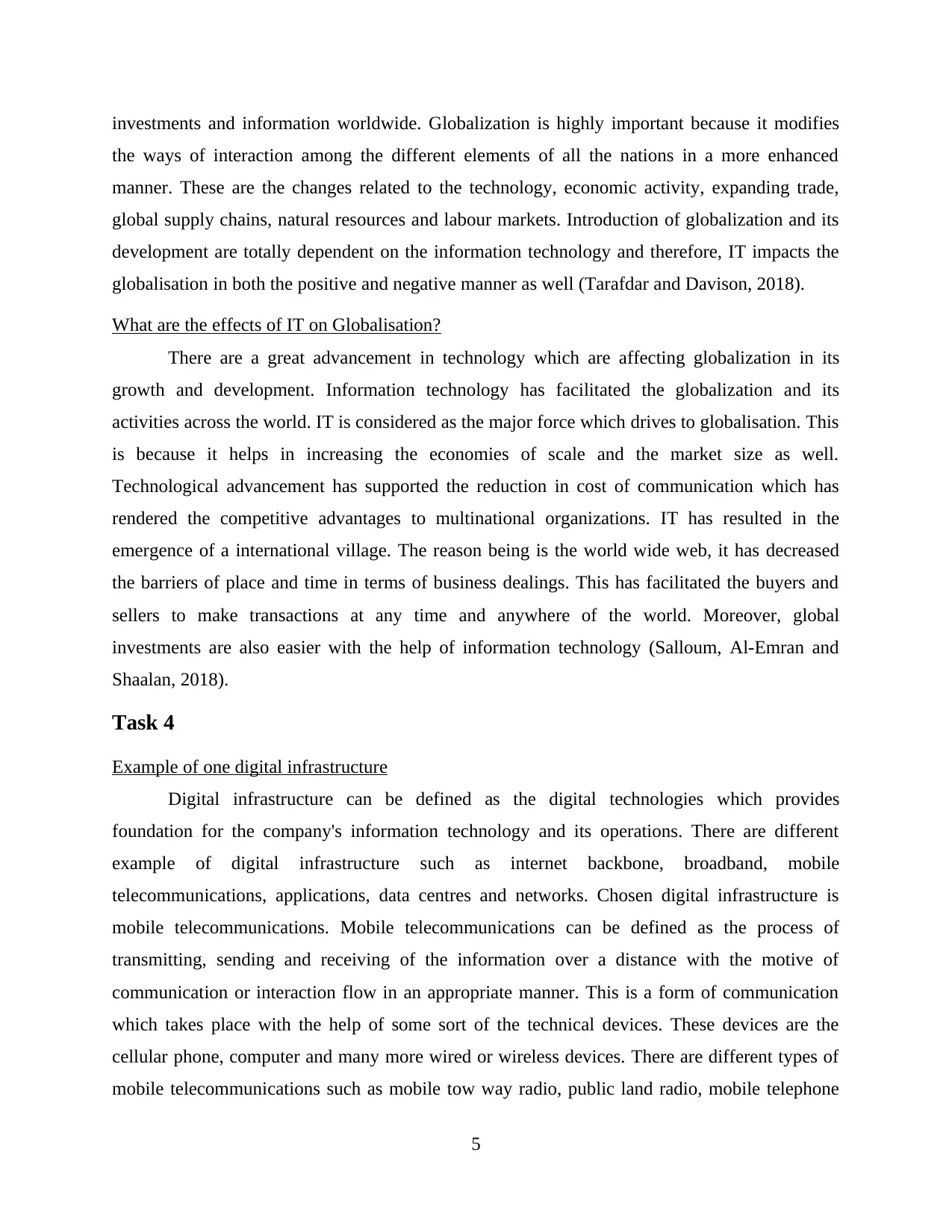
investments and information worldwide. Globalization is highly important because it modifies
the ways of interaction among the different elements of all the nations in a more enhanced
manner. These are the changes related to the technology, economic activity, expanding trade,
global supply chains, natural resources and labour markets. Introduction of globalization and its
development are totally dependent on the information technology and therefore, IT impacts the
globalisation in both the positive and negative manner as well (Tarafdar and Davison, 2018).
What are the effects of IT on Globalisation?
There are a great advancement in technology which are affecting globalization in its
growth and development. Information technology has facilitated the globalization and its
activities across the world. IT is considered as the major force which drives to globalisation. This
is because it helps in increasing the economies of scale and the market size as well.
Technological advancement has supported the reduction in cost of communication which has
rendered the competitive advantages to multinational organizations. IT has resulted in the
emergence of a international village. The reason being is the world wide web, it has decreased
the barriers of place and time in terms of business dealings. This has facilitated the buyers and
sellers to make transactions at any time and anywhere of the world. Moreover, global
investments are also easier with the help of information technology (Salloum, Al-Emran and
Shaalan, 2018).
Task 4
Example of one digital infrastructure
Digital infrastructure can be defined as the digital technologies which provides
foundation for the company's information technology and its operations. There are different
example of digital infrastructure such as internet backbone, broadband, mobile
telecommunications, applications, data centres and networks. Chosen digital infrastructure is
mobile telecommunications. Mobile telecommunications can be defined as the process of
transmitting, sending and receiving of the information over a distance with the motive of
communication or interaction flow in an appropriate manner. This is a form of communication
which takes place with the help of some sort of the technical devices. These devices are the
cellular phone, computer and many more wired or wireless devices. There are different types of
mobile telecommunications such as mobile tow way radio, public land radio, mobile telephone
5
the ways of interaction among the different elements of all the nations in a more enhanced
manner. These are the changes related to the technology, economic activity, expanding trade,
global supply chains, natural resources and labour markets. Introduction of globalization and its
development are totally dependent on the information technology and therefore, IT impacts the
globalisation in both the positive and negative manner as well (Tarafdar and Davison, 2018).
What are the effects of IT on Globalisation?
There are a great advancement in technology which are affecting globalization in its
growth and development. Information technology has facilitated the globalization and its
activities across the world. IT is considered as the major force which drives to globalisation. This
is because it helps in increasing the economies of scale and the market size as well.
Technological advancement has supported the reduction in cost of communication which has
rendered the competitive advantages to multinational organizations. IT has resulted in the
emergence of a international village. The reason being is the world wide web, it has decreased
the barriers of place and time in terms of business dealings. This has facilitated the buyers and
sellers to make transactions at any time and anywhere of the world. Moreover, global
investments are also easier with the help of information technology (Salloum, Al-Emran and
Shaalan, 2018).
Task 4
Example of one digital infrastructure
Digital infrastructure can be defined as the digital technologies which provides
foundation for the company's information technology and its operations. There are different
example of digital infrastructure such as internet backbone, broadband, mobile
telecommunications, applications, data centres and networks. Chosen digital infrastructure is
mobile telecommunications. Mobile telecommunications can be defined as the process of
transmitting, sending and receiving of the information over a distance with the motive of
communication or interaction flow in an appropriate manner. This is a form of communication
which takes place with the help of some sort of the technical devices. These devices are the
cellular phone, computer and many more wired or wireless devices. There are different types of
mobile telecommunications such as mobile tow way radio, public land radio, mobile telephone
5
Paraphrase This Document
Need a fresh take? Get an instant paraphrase of this document with our AI Paraphraser
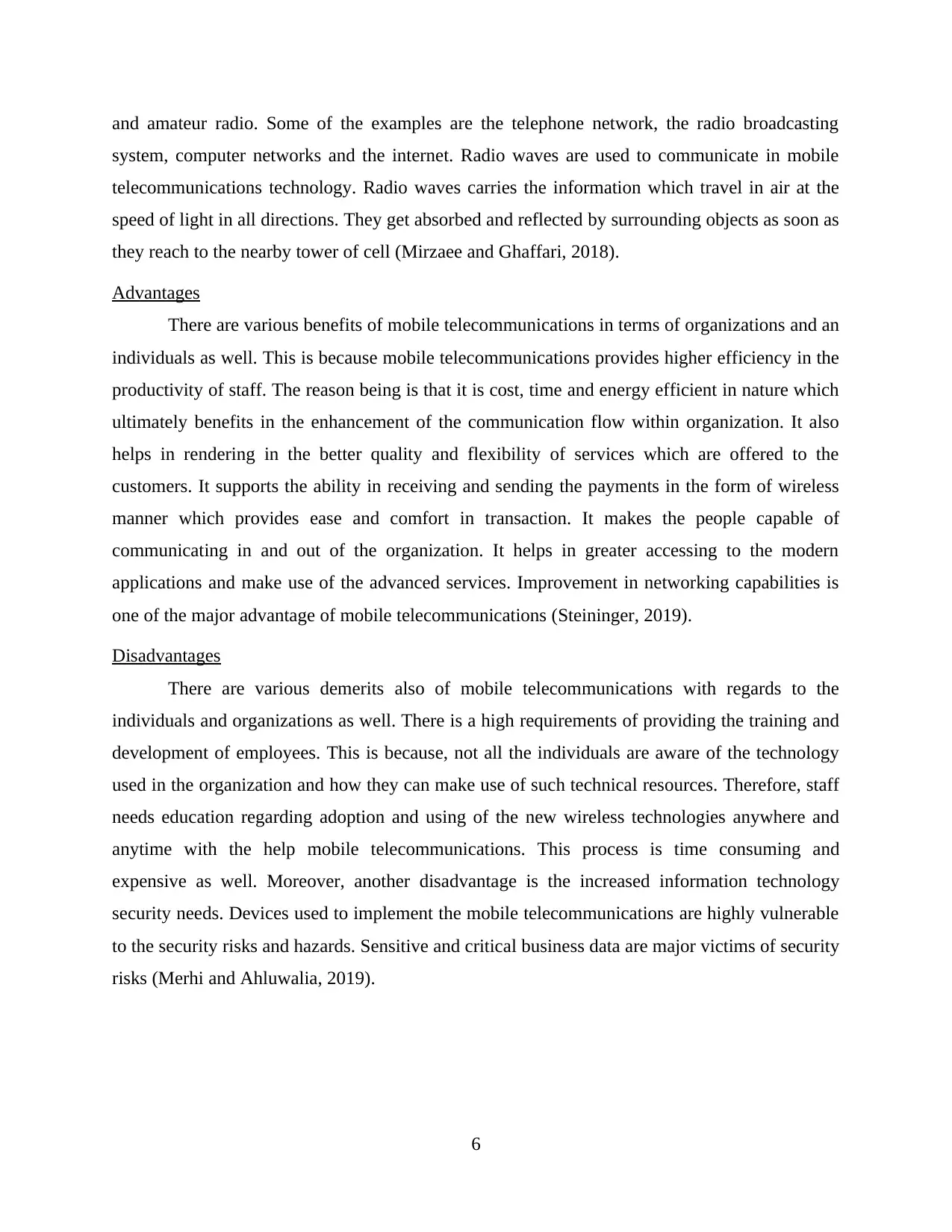
and amateur radio. Some of the examples are the telephone network, the radio broadcasting
system, computer networks and the internet. Radio waves are used to communicate in mobile
telecommunications technology. Radio waves carries the information which travel in air at the
speed of light in all directions. They get absorbed and reflected by surrounding objects as soon as
they reach to the nearby tower of cell (Mirzaee and Ghaffari, 2018).
Advantages
There are various benefits of mobile telecommunications in terms of organizations and an
individuals as well. This is because mobile telecommunications provides higher efficiency in the
productivity of staff. The reason being is that it is cost, time and energy efficient in nature which
ultimately benefits in the enhancement of the communication flow within organization. It also
helps in rendering in the better quality and flexibility of services which are offered to the
customers. It supports the ability in receiving and sending the payments in the form of wireless
manner which provides ease and comfort in transaction. It makes the people capable of
communicating in and out of the organization. It helps in greater accessing to the modern
applications and make use of the advanced services. Improvement in networking capabilities is
one of the major advantage of mobile telecommunications (Steininger, 2019).
Disadvantages
There are various demerits also of mobile telecommunications with regards to the
individuals and organizations as well. There is a high requirements of providing the training and
development of employees. This is because, not all the individuals are aware of the technology
used in the organization and how they can make use of such technical resources. Therefore, staff
needs education regarding adoption and using of the new wireless technologies anywhere and
anytime with the help mobile telecommunications. This process is time consuming and
expensive as well. Moreover, another disadvantage is the increased information technology
security needs. Devices used to implement the mobile telecommunications are highly vulnerable
to the security risks and hazards. Sensitive and critical business data are major victims of security
risks (Merhi and Ahluwalia, 2019).
6
system, computer networks and the internet. Radio waves are used to communicate in mobile
telecommunications technology. Radio waves carries the information which travel in air at the
speed of light in all directions. They get absorbed and reflected by surrounding objects as soon as
they reach to the nearby tower of cell (Mirzaee and Ghaffari, 2018).
Advantages
There are various benefits of mobile telecommunications in terms of organizations and an
individuals as well. This is because mobile telecommunications provides higher efficiency in the
productivity of staff. The reason being is that it is cost, time and energy efficient in nature which
ultimately benefits in the enhancement of the communication flow within organization. It also
helps in rendering in the better quality and flexibility of services which are offered to the
customers. It supports the ability in receiving and sending the payments in the form of wireless
manner which provides ease and comfort in transaction. It makes the people capable of
communicating in and out of the organization. It helps in greater accessing to the modern
applications and make use of the advanced services. Improvement in networking capabilities is
one of the major advantage of mobile telecommunications (Steininger, 2019).
Disadvantages
There are various demerits also of mobile telecommunications with regards to the
individuals and organizations as well. There is a high requirements of providing the training and
development of employees. This is because, not all the individuals are aware of the technology
used in the organization and how they can make use of such technical resources. Therefore, staff
needs education regarding adoption and using of the new wireless technologies anywhere and
anytime with the help mobile telecommunications. This process is time consuming and
expensive as well. Moreover, another disadvantage is the increased information technology
security needs. Devices used to implement the mobile telecommunications are highly vulnerable
to the security risks and hazards. Sensitive and critical business data are major victims of security
risks (Merhi and Ahluwalia, 2019).
6
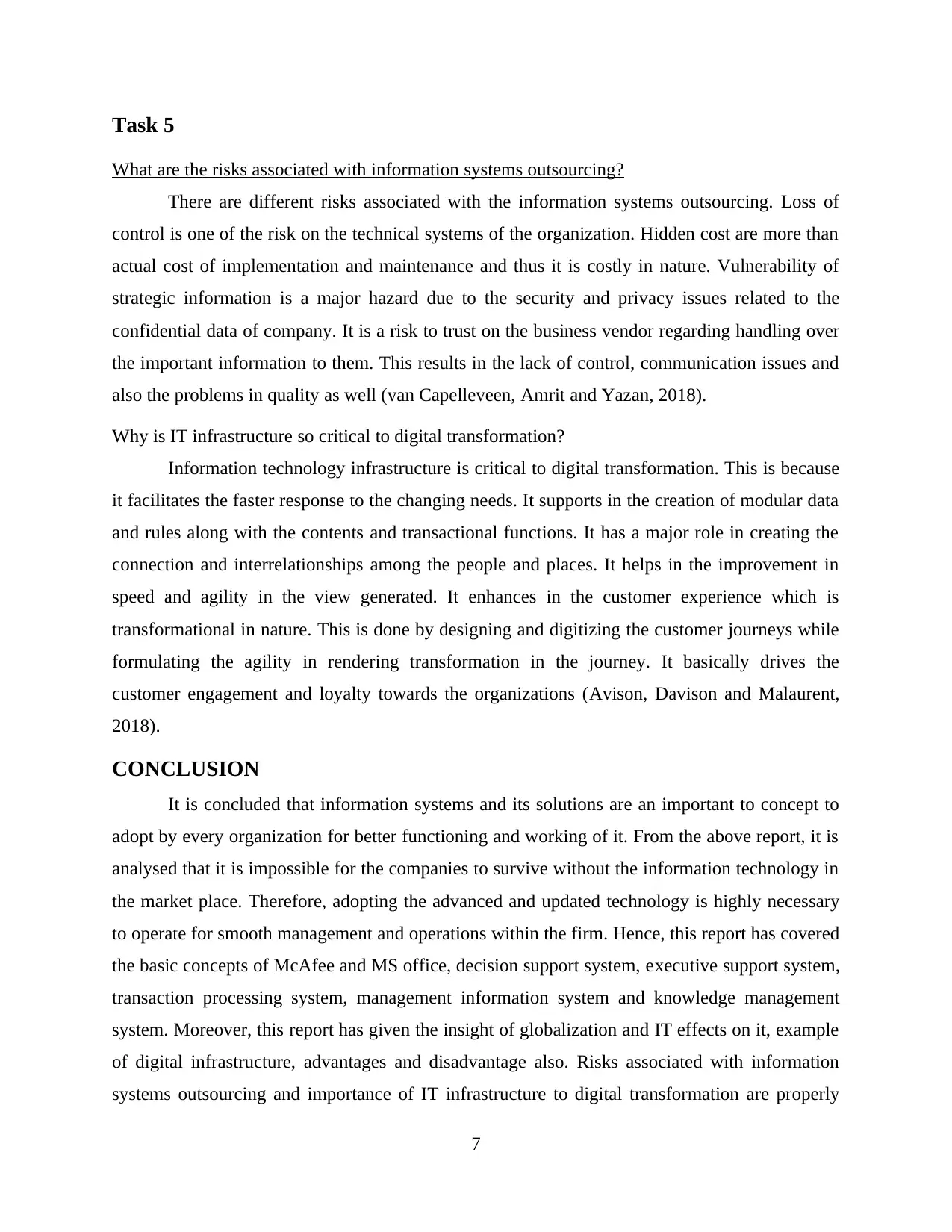
Task 5
What are the risks associated with information systems outsourcing?
There are different risks associated with the information systems outsourcing. Loss of
control is one of the risk on the technical systems of the organization. Hidden cost are more than
actual cost of implementation and maintenance and thus it is costly in nature. Vulnerability of
strategic information is a major hazard due to the security and privacy issues related to the
confidential data of company. It is a risk to trust on the business vendor regarding handling over
the important information to them. This results in the lack of control, communication issues and
also the problems in quality as well (van Capelleveen, Amrit and Yazan, 2018).
Why is IT infrastructure so critical to digital transformation?
Information technology infrastructure is critical to digital transformation. This is because
it facilitates the faster response to the changing needs. It supports in the creation of modular data
and rules along with the contents and transactional functions. It has a major role in creating the
connection and interrelationships among the people and places. It helps in the improvement in
speed and agility in the view generated. It enhances in the customer experience which is
transformational in nature. This is done by designing and digitizing the customer journeys while
formulating the agility in rendering transformation in the journey. It basically drives the
customer engagement and loyalty towards the organizations (Avison, Davison and Malaurent,
2018).
CONCLUSION
It is concluded that information systems and its solutions are an important to concept to
adopt by every organization for better functioning and working of it. From the above report, it is
analysed that it is impossible for the companies to survive without the information technology in
the market place. Therefore, adopting the advanced and updated technology is highly necessary
to operate for smooth management and operations within the firm. Hence, this report has covered
the basic concepts of McAfee and MS office, decision support system, executive support system,
transaction processing system, management information system and knowledge management
system. Moreover, this report has given the insight of globalization and IT effects on it, example
of digital infrastructure, advantages and disadvantage also. Risks associated with information
systems outsourcing and importance of IT infrastructure to digital transformation are properly
7
What are the risks associated with information systems outsourcing?
There are different risks associated with the information systems outsourcing. Loss of
control is one of the risk on the technical systems of the organization. Hidden cost are more than
actual cost of implementation and maintenance and thus it is costly in nature. Vulnerability of
strategic information is a major hazard due to the security and privacy issues related to the
confidential data of company. It is a risk to trust on the business vendor regarding handling over
the important information to them. This results in the lack of control, communication issues and
also the problems in quality as well (van Capelleveen, Amrit and Yazan, 2018).
Why is IT infrastructure so critical to digital transformation?
Information technology infrastructure is critical to digital transformation. This is because
it facilitates the faster response to the changing needs. It supports in the creation of modular data
and rules along with the contents and transactional functions. It has a major role in creating the
connection and interrelationships among the people and places. It helps in the improvement in
speed and agility in the view generated. It enhances in the customer experience which is
transformational in nature. This is done by designing and digitizing the customer journeys while
formulating the agility in rendering transformation in the journey. It basically drives the
customer engagement and loyalty towards the organizations (Avison, Davison and Malaurent,
2018).
CONCLUSION
It is concluded that information systems and its solutions are an important to concept to
adopt by every organization for better functioning and working of it. From the above report, it is
analysed that it is impossible for the companies to survive without the information technology in
the market place. Therefore, adopting the advanced and updated technology is highly necessary
to operate for smooth management and operations within the firm. Hence, this report has covered
the basic concepts of McAfee and MS office, decision support system, executive support system,
transaction processing system, management information system and knowledge management
system. Moreover, this report has given the insight of globalization and IT effects on it, example
of digital infrastructure, advantages and disadvantage also. Risks associated with information
systems outsourcing and importance of IT infrastructure to digital transformation are properly
7

examined in the above report. This is done for better understanding and implementation of such
conceptions in the real world organizations.
8
conceptions in the real world organizations.
8
Secure Best Marks with AI Grader
Need help grading? Try our AI Grader for instant feedback on your assignments.
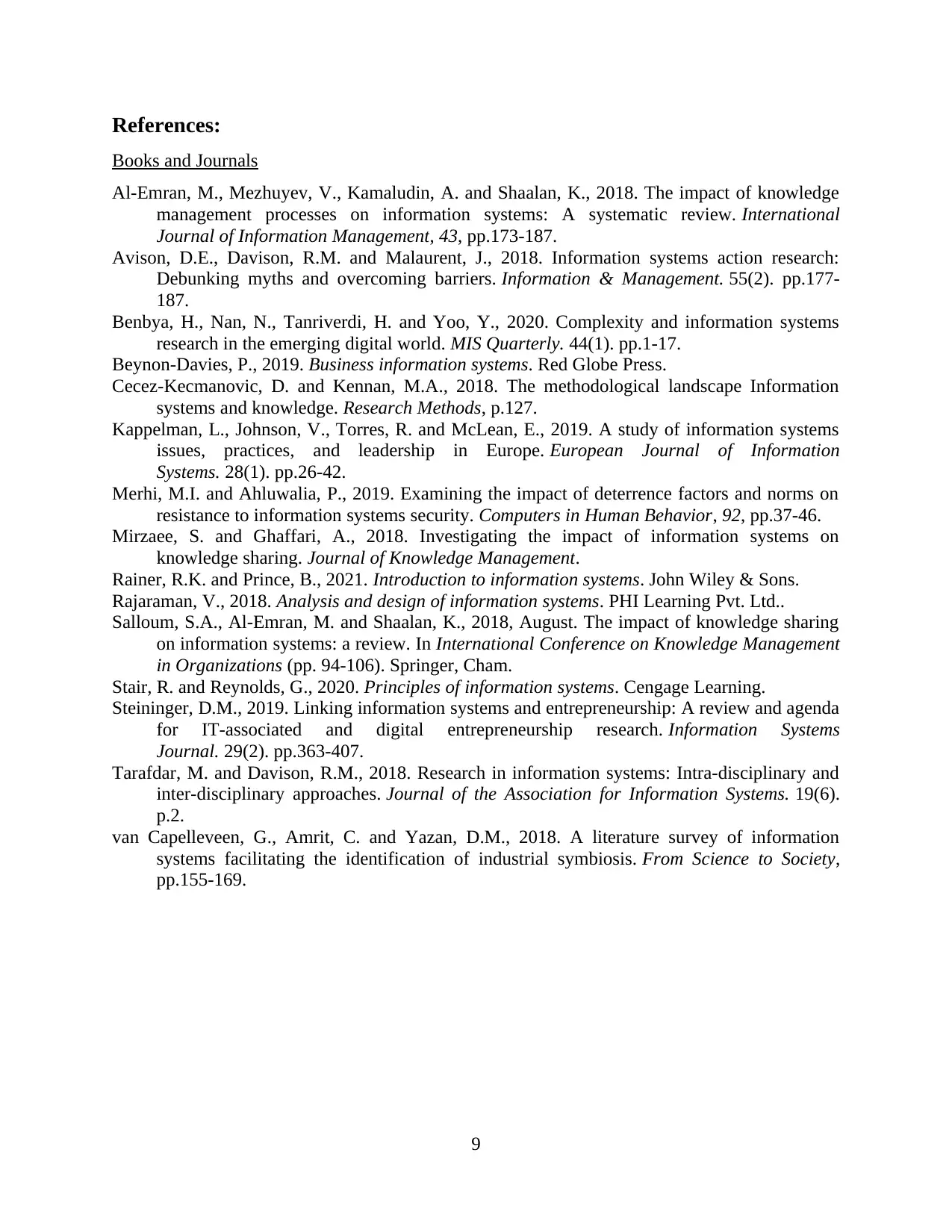
References:
Books and Journals
Al-Emran, M., Mezhuyev, V., Kamaludin, A. and Shaalan, K., 2018. The impact of knowledge
management processes on information systems: A systematic review. International
Journal of Information Management, 43, pp.173-187.
Avison, D.E., Davison, R.M. and Malaurent, J., 2018. Information systems action research:
Debunking myths and overcoming barriers. Information & Management. 55(2). pp.177-
187.
Benbya, H., Nan, N., Tanriverdi, H. and Yoo, Y., 2020. Complexity and information systems
research in the emerging digital world. MIS Quarterly. 44(1). pp.1-17.
Beynon-Davies, P., 2019. Business information systems. Red Globe Press.
Cecez-Kecmanovic, D. and Kennan, M.A., 2018. The methodological landscape Information
systems and knowledge. Research Methods, p.127.
Kappelman, L., Johnson, V., Torres, R. and McLean, E., 2019. A study of information systems
issues, practices, and leadership in Europe. European Journal of Information
Systems. 28(1). pp.26-42.
Merhi, M.I. and Ahluwalia, P., 2019. Examining the impact of deterrence factors and norms on
resistance to information systems security. Computers in Human Behavior, 92, pp.37-46.
Mirzaee, S. and Ghaffari, A., 2018. Investigating the impact of information systems on
knowledge sharing. Journal of Knowledge Management.
Rainer, R.K. and Prince, B., 2021. Introduction to information systems. John Wiley & Sons.
Rajaraman, V., 2018. Analysis and design of information systems. PHI Learning Pvt. Ltd..
Salloum, S.A., Al-Emran, M. and Shaalan, K., 2018, August. The impact of knowledge sharing
on information systems: a review. In International Conference on Knowledge Management
in Organizations (pp. 94-106). Springer, Cham.
Stair, R. and Reynolds, G., 2020. Principles of information systems. Cengage Learning.
Steininger, D.M., 2019. Linking information systems and entrepreneurship: A review and agenda
for IT‐associated and digital entrepreneurship research. Information Systems
Journal. 29(2). pp.363-407.
Tarafdar, M. and Davison, R.M., 2018. Research in information systems: Intra-disciplinary and
inter-disciplinary approaches. Journal of the Association for Information Systems. 19(6).
p.2.
van Capelleveen, G., Amrit, C. and Yazan, D.M., 2018. A literature survey of information
systems facilitating the identification of industrial symbiosis. From Science to Society,
pp.155-169.
9
Books and Journals
Al-Emran, M., Mezhuyev, V., Kamaludin, A. and Shaalan, K., 2018. The impact of knowledge
management processes on information systems: A systematic review. International
Journal of Information Management, 43, pp.173-187.
Avison, D.E., Davison, R.M. and Malaurent, J., 2018. Information systems action research:
Debunking myths and overcoming barriers. Information & Management. 55(2). pp.177-
187.
Benbya, H., Nan, N., Tanriverdi, H. and Yoo, Y., 2020. Complexity and information systems
research in the emerging digital world. MIS Quarterly. 44(1). pp.1-17.
Beynon-Davies, P., 2019. Business information systems. Red Globe Press.
Cecez-Kecmanovic, D. and Kennan, M.A., 2018. The methodological landscape Information
systems and knowledge. Research Methods, p.127.
Kappelman, L., Johnson, V., Torres, R. and McLean, E., 2019. A study of information systems
issues, practices, and leadership in Europe. European Journal of Information
Systems. 28(1). pp.26-42.
Merhi, M.I. and Ahluwalia, P., 2019. Examining the impact of deterrence factors and norms on
resistance to information systems security. Computers in Human Behavior, 92, pp.37-46.
Mirzaee, S. and Ghaffari, A., 2018. Investigating the impact of information systems on
knowledge sharing. Journal of Knowledge Management.
Rainer, R.K. and Prince, B., 2021. Introduction to information systems. John Wiley & Sons.
Rajaraman, V., 2018. Analysis and design of information systems. PHI Learning Pvt. Ltd..
Salloum, S.A., Al-Emran, M. and Shaalan, K., 2018, August. The impact of knowledge sharing
on information systems: a review. In International Conference on Knowledge Management
in Organizations (pp. 94-106). Springer, Cham.
Stair, R. and Reynolds, G., 2020. Principles of information systems. Cengage Learning.
Steininger, D.M., 2019. Linking information systems and entrepreneurship: A review and agenda
for IT‐associated and digital entrepreneurship research. Information Systems
Journal. 29(2). pp.363-407.
Tarafdar, M. and Davison, R.M., 2018. Research in information systems: Intra-disciplinary and
inter-disciplinary approaches. Journal of the Association for Information Systems. 19(6).
p.2.
van Capelleveen, G., Amrit, C. and Yazan, D.M., 2018. A literature survey of information
systems facilitating the identification of industrial symbiosis. From Science to Society,
pp.155-169.
9
1 out of 11
Related Documents
Your All-in-One AI-Powered Toolkit for Academic Success.
+13062052269
info@desklib.com
Available 24*7 on WhatsApp / Email
![[object Object]](/_next/static/media/star-bottom.7253800d.svg)
Unlock your academic potential
© 2024 | Zucol Services PVT LTD | All rights reserved.



